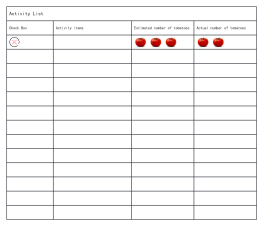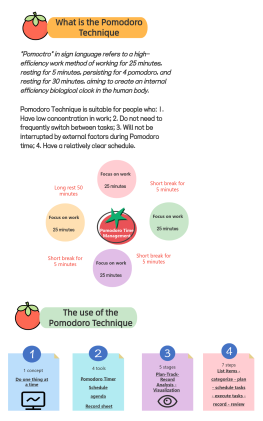
Pomodoro Technique
0 Report
This mind map provides a comprehensive overview of the Pomodoro Technique, a time management method designed to enhance productivity and focus. The technique is based on the principle of using a timer to break work into 25-minute intervals, known as Pomodoros, with short breaks in between. Key guidelines include indivisible Pomodoros, dividing tasks exceeding three hours, and not pausing once started. The method involves planning daily tasks, using a timer, and taking regular breaks to maintain efficiency. Advantages of this technique include alleviating time anxiety, improving focus, and balancing work and rest, ultimately fostering self-motivation and goal achievement.
Related Recommendations
Other works by the author
Outline/Content
See more
Basic Principle
1. The Pomodoro timer cannot be divided.
2. Tasks taking more than 3 hours need to be further divided.
3. Once a Pomodoro starts, it cannot be paused. If it is paused, it can only be discarded and restarted.
4. If an activity takes less than a pomodoro, it can be combined with other activities.
5. The Pomodoro Technique is not used for activities during vacations and rest periods.
Execute the method
1. Plan a few tasks to be completed today at the beginning of each day, write the tasks one by one in the list (or record them in the software list)
2. Set your tomato clock (timer, software, alarm clock, etc.) for 25 minutes.
3. Start working on the first task until the Pomodoro timer rings or reminds (25 minutes to go).
4. Stop working, and put an X after the task in the list.
5. Rest for 3-5 minutes, move around, drink water, use the bathroom, etc.
6. Start the next Pomodoro and continue the task. Keep looping until the task is completed and cross it off the list.
7. After every four Pomodoro sessions, take a 25-minute break.
Method Advantages
1. Alleviate time anxiety
2. Improve focus and reduce interruptions
3、Flexible time arrangement
4、Easier to achieve goals, self-motivation
5. Balance work and rest, and have a more positive psychological implication when starting work next time

Collect

Collect

0 Comments
Next Page



